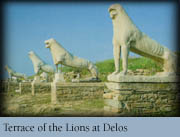
For more than twenty-seven centuries a series of carved marble lions have marked the processional way on Delos. A gift of the island of Naxos, the lions originally guarded the sacred lake which,according to Greek myth, was the birthplace of the god Apollo, offspring of Zeus and Leto. Although the more visually spectacular sanctuary at Delphi soon became the primary site for receiving the god's oracles, Delos was the home of a splendid festival held in his honor. Scarcely three miles long by a mile wide, Delos' size belies its religious and commercial significance in the ancient world. The island reached its greatest period of social and economic importance in the last two centuries BCE. In fact, during this period it became a major trade center, and its population increased dramatically. In antiquity, commercial trade usually brought an influx of new cults and religious associations in its wake. The Egyptian cults of Isis and Sarapis, which became extremely popular throughout the Roman empire during the early Christian period, were brought to Delos by missionaries during this earlier period. In addition to these and other popular and widely known cults, the traders and merchants of Delos also established a number of professional associations under the patronage of various gods who were in a position to offer them special protection. Even today, visitors to the island can see the remains of the meeting hall of the Poseidoniasts and the House of Hermes. That is why it is especially interesting that archaeologists have aslo excavated the remains of a small synagogue on the outskirts of the island. Since it can be dated to the second century BCE, it is the oldest known synagogue in the Greek world. Like the Poseidoniasts or the members of the House of Hermes, the Samaritans who established this particular assembly hall in hommage to "the Highest God" were probably merchants and traders. And even though the economic importance of Delos had declined sharply by the dawn of the common era, this synagogue remained in use well into the second century CE.